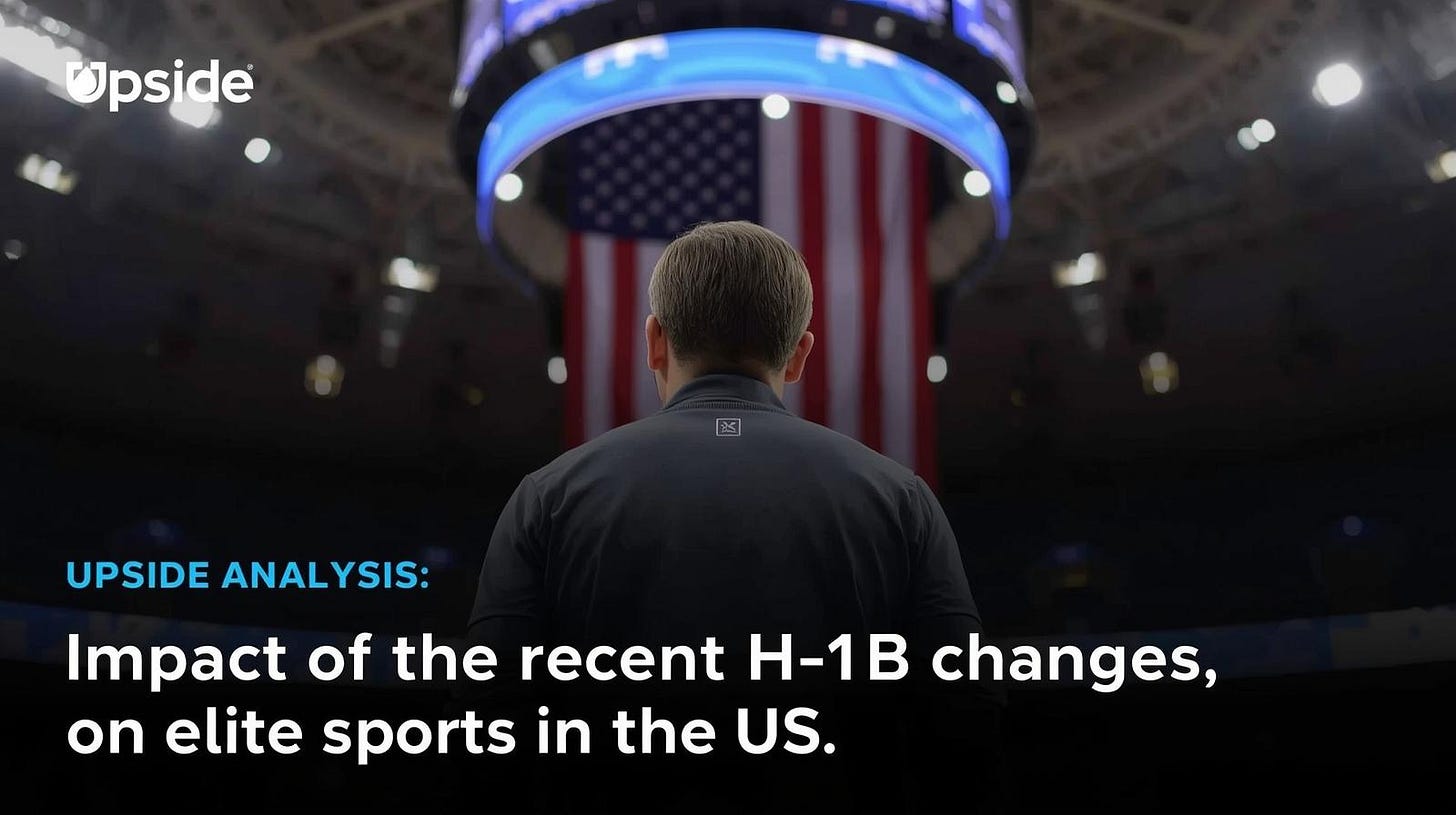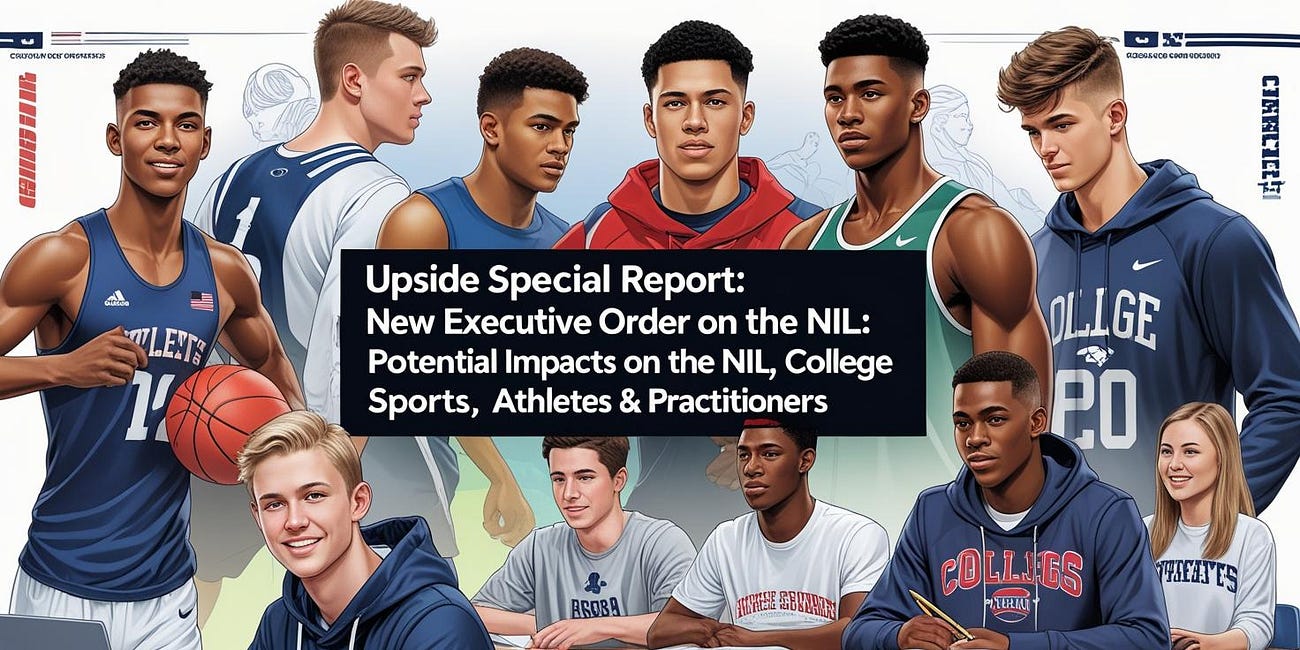🇺🇸 Upside Analysis: Impact of the Trump Administration’s recent H-1B Changes on Elite Sports in the United States
In September 2025 the White House announced a package of measures that substantially reshape the H-1B program (new one-time fees, heavier enforcement and a proposed move to a wage-weighted selection process). Although the policy thread is aimed at high-tech and research employers, its ripple effects will extend into elite sport — teams, leagues, universities and sport tech providers that rely on foreign coaches, athletic trainers, sports scientists and specialist practitioners. This analysis explains the policy components, how they affect foreign practitioners (Australia, New Zealand, Europe, etc.), whether the rule is likely to last, practical next steps, recommendations for U.S. teams, and a short conclusion.
What the new H-1B policy is about
Two distinct but related actions matter:
Presidential proclamation / executive action (Sept. 19, 2025) — a one-time $100,000 fee on new H-1B petitions filed from abroad and a “restriction on entry” framework that applies to certain new nonimmigrant workers; the proclamation took effect Sept. 21, 2025 and is currently framed as a time-limited measure (12 months in text). (Source: The White House)
DHS / USCIS rulemaking (proposed Sept. 24, 2025) — a regulatory proposal to replace the purely random H-1B cap lottery with a weighted, wage-level selection that prioritizes higher-paid jobs (and to update prevailing wage calculations and compliance measures). That proposal is currently at the notice-and-comment / rulemaking stage and would require final regulatory steps before becoming binding. (Source: Federal Register)
Taken together the policy package raises the cost of filing many new H-1B petitions, changes who wins cap slots (favoring higher-wage roles), and increases enforcement risk and documentation scrutiny for employers. Legal and industry briefings summarize the likely operational impact for employers. Morgan Lewis+1
Impacts on foreign practitioners (Australia, New Zealand, Europe, etc.)
1) Immediate financial barrier for smaller employers and leagues
The new $100K fee (applies to new petitions filed abroad) dramatically increases the up-front cost of hiring an H-1B worker. Tech firms and deep-pocket employers have already signaled they will absorb or offset the cost, but smaller teams, minor-league affiliates, boutique sports tech startups, and college programs are far less able to do so — meaning clubs that historically brought in specialists (sports scientists, strength & conditioning leads, athletic trainers) on H-1Bs may pause or stop filings. This hits practitioners from Australia, New Zealand and Europe who typically come on H-1B when their skillset matches a “specialty occupation.” (Source: American Immigration Council)
2) Wage-weighted selection disfavors entry-level/salary-constrained roles
If USCIS implements a wage-weighted selection that favors higher occupational wage levels, cap slots become more likely for senior, high-paid technical hires and less likely for lower-paid but highly specialized roles. Many athletic support roles (assistant athletic trainers, entry-level sports scientists, performance analysts) often sit at lower prevailing-wage levels than, say, senior engineers — so practitioners from Australia/NZ/Europe who would normally enter on H-1B could see reduced chances in the cap. That creates a systemic squeeze on mid-career practitioners seeking U.S. jobs. (Source: Federal Register)
3) Universities and NCAA programs face budget and continuity risk
Colleges and athletic departments that depend on a steady pipeline of international staff (graduate assistants who later convert to staff roles, visiting researchers, trainers) will be exposed both to higher cost and stricter selection. Several universities are already publicly assessing six- and seven-figure exposures and cautioning staff about travel/processing. This compounds roster and program continuity issues for teams that rely on experienced international practitioners. (Source: The Times of India)
4) Country-specific implications
Australians & New Zealanders: often come as coaches, high-performance leads or sports scientists. Many such hires are mid-career specialists (not necessarily “extraordinary” by O-1 standards) — they’ll most commonly rely on H-1B or P-1 where eligible. H-1B changes make those pathways more expensive and uncertain.
Europeans: the same dynamics apply; Europeans who are not dual nationals with Canada/Mexico cannot use TN and will face H-1B cap pressure unless they qualify for O-1/P-1 or alternate visas.
Canadians & Mexicans: retain the TN route (USMCA/TN) as an accessible alternative for eligible professions — that preserves a somewhat easier pipeline for teams hiring from Canada in particular. (Source: USCIS)
5) Talent pipeline and competitive balance risks
Elite sports increasingly depend on niche expertise (biomechanics, applied sports science, data analytics). If smaller clubs and collegiate programs reduce international hires, expertise will concentrate at well-funded teams and firms able to absorb fees — worsening competitive imbalance and slowing diffusion of best practices across the system. Legal and HR costs also rise because employers must navigate new wage rules and compliance. (Source: Morgan Lewis)
Why the new rule might drive greater adoption of internships in the U.S. among foreign practitioners
One potential side effect of the new H-1B framework is a likely increase in the use of internships, fellowships, and exchange programs as alternative entry routes for foreign practitioners seeking U.S. experience. With the new one-time fee and wage-based selection process raising both financial and administrative barriers, teams and sport organizations may turn to short-term training or internship models — often under J-1 or F-1 visa categories — to evaluate and develop international talent before committing to a full H-1B sponsorship. These programs offer mutual benefits: foreign practitioners can gain exposure to U.S. methodologies, facilities, and professional networks, while teams maintain flexibility and compliance with immigration rules. Over time, this shift could create a more structured pipeline where internships and visiting fellowships become the de facto proving ground for future full-time roles in elite sport performance, science, and technology.
Whether or not this new rule is here to stay
Short answer: uncertain — but expect the high-level direction to persist unless Congress or the courts intervene.
The presidential proclamation implementing the $100K fee is time-limited in text (effective Sept. 21, 2025, through Sept. 21, 2026, unless extended) — that means it can be rescinded, extended, or litigated. Several legal challenges and institutional pushback are likely given the scale of fees and its disproportionate effect on universities and research institutions. (Source: Carnegie Mellon University)
The DHS/USCIS proposed rule to weight selections by wage is in the formal rulemaking pipeline and will face public comments and probable litigation; finalization will take months. Even if finalized, future administrations or Congress could amend the statutes or reverse aspects. (Source: Federal Register)
Political reality: the administration has signaled a durable preference for prioritizing “American workers” and higher-paid visas; so while specific mechanics (fee amount, weighting algorithm, exemptions) can change, the general trend toward prioritization and costlier new filings is likely to remain unless reversed by legislation or the courts. For employers in elite sport, that means planning for a medium-term period (12–24 months) of elevated costs and uncertainty. (Source: Morgan Lewis)
Where do we go from here?
Rapid adaptation by deep-pocket employers: large professional teams, leagues and major universities will likely absorb fees or centralize visa sponsorship through league offices, foundations or university systems to maintain access to talent. Evidence: large tech firms have already stated they will cover fees. That pattern could repeat in top sports franchises. (Source: Business Insider)
Re-routing to alternate visa categories: more practitioners will be hired via O-1 (extraordinary ability), P-1 (athletes/teams and their essential support personnel), or TN (Canada/Mexico) where feasible — pushing an administrative and legal shift in how roles are framed and documented. (Source: USCIS)
Consolidation of specialist services offshore or through remote contracts: teams may contract foreign specialists remotely or with short-term visits rather than full employment sponsorship. This lowers costs but reduces on-site, day-to-day impact.
Talent development domestically: increased investment in domestic training pipelines (internships, graduate programs) to reduce dependence on foreign hires — though that’s a multi-year remedy.
Legal and lobbying pushback: universities, leagues and major employers will escalate legal and policy advocacy, seeking exemptions (for universities, sports organizations, or small employers) or lighter fee structures. (Source: Morgan Lewis)
Recommendations to teams in the U.S.
Conduct a rapid audit of immigration exposure
Identify staff on H-1B, pending petitions, graduate assistants likely to convert, and near-term hires. Quantify potential incremental costs (including a possible $100K per new petition) and administrative risk. (This is the foundation for all other moves.)
Prioritize which hires truly require H-1B and which can use alternatives
TN (USMCA) for Canadian/Mexican professionals where job classification fits. (Source: USCIS
O-1 for coaches/athletes with clear national/international acclaim (more documentation but avoids cap). (Source: USCIS)
P-1 for internationally recognized teams/athletes and some essential support personnel (useful for short-term competition/tours). (Source:USCIS)
Centralize immigration sponsorship at league or university system level
Leagues, conferences or university systems can pool resources to absorb fees and spread compliance costs; centralized legal teams can enforce consistent documentation and wage classification.
Budget and contract adjustments
Add visa-contingency clauses to offer letters, and consider temporary remote start dates or contractor arrangements if visa processing is delayed or prohibitive. Ensure any contingency language is legally reviewed to avoid discrimination claims.
Invest in domestic pipelines
Expand internships, fellowship programs, and graduate assistant pipelines to train domestic practitioners (strength & conditioning, applied sports science) — a multi-year hedge against constrained international hiring.
Legal preparedness and lobbying
Engage immigration counsel to track the DHS rulemaking (comment deadlines, transitional rules) and to prepare for complex filings (prevailing wage documentation). Coordinate with leagues and universities to lobby for specific carve-outs (e.g., athletic trainers, university employees, minor-league affiliates). (Source: Federal Register)
Consider alternative resourcing models
Outsource certain specialist functions to domestic consultancies or hire international experts on short-term P-1/O-1 arrangements or as contractors for remote support, while preserving key in-house roles for long-term continuity.
Conclusion
The September 2025 H-1B package (presidential proclamation + DHS proposed rule) represents a meaningful repositioning of U.S. work-visa policy: higher immediate costs, a bias toward higher-wage hires, and tighter compliance. While the stated targets are tech and high-volume H-1B users, elite sport is exposed through athletic trainers, coaches, sports scientists and niche technologists who often enter on H-1Bs. The immediate consequences are higher costs and greater uncertainty for smaller teams, universities and sports startups; the medium-term picture is redistribution of talent toward well-funded organizations, increased reliance on alternative visa classes (O-1, P-1, TN), and accelerated domestic talent development. Whether the policy remains unchanged depends on litigation, future rulemaking and political dynamics, but teams should assume elevated friction for at least the next 12–24 months and act accordingly.
You may also like:
📈 Upside Special Report: Trump’s Executive Order On The NIL/NCAA: Potential Impacts on The NIL, College Sports, Athletes & Practitioners
Donald Trump’s July 24, 2025 executive order markedly intervenes in college sports, aiming to regulate Name, Image, and Likeness (NIL) deals and preserve the amateur nature of college athletics. It directly addresses concerns around booster-driven “pay-for-play” schemes, resource imbalances, and the viability of non-revenue and women’s sports.


